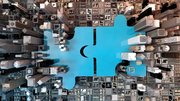News
Stars of the future in the ATM galaxy
Mike Lee, ATMIA's international director, does a little stargazing in the ATM galaxy.
September 4, 2003
As a member of the Future Trends Executive Round Table hosted by ATMmarketplace, I was asked to forecast ATM developments through a five-year period up to 2008. This forced me to become a stargazer in the ATM universe.
What I saw was, if you will excuse the pun, astronomical. There are many rising stars in the ATM industry, as well as what astronomers would call red giants, which are waning stars that are burning themselves out.
The American astronomer Edwin Hubble showed in 1929 that our universe is expanding. Galaxies furthest from us are hurtling away at greater speeds, in the region of 60,000 kilometers (37,284 miles) a second!
 |
ATM International Director Mike Lee |
Our ATM universe is expanding, too, although not quite at a comparable rate. According to Retail Banking Research, we are growing at a rate of 221.7 machines per day, which is 9.2 per hour and 0.15 per minute.
Star gazing
Come with me on our ATM Space Odyssey 2008 as we ride through the Milky Way of the future. What celestial bodies are we going to look for?
First of all, we must try to spot blue and red stars. When a star is young and hot, it has a blue color, whereas when hydrogen becomes depleted, it evolves into a giant red star as it starts its decline. Then we must identify planets, which are more stable places than fiery stars.
Let us also see if we can observe any comets in action. A comet is a ball of ice, dust and gas that orbits the sun and has a tail of gas trailing behind it, brilliant but doomed to early extinction. Finally, we had better avoid any black holes, thought to be stars that have collapsed in on themselves through enormous gravitational pull, light no longer being emitted from them.
Two recent incidents that happened to me will shed some light on what we might see on our galactic tour of the future.
Internet rising
The first incident concerns Internet banking. You may have read about the recent case of a hacker defrauding several online bank accounts at a major South African bank -- a suspect has been arrested and is on trial for 10 charges of fraud totaling 530,000 rand (about $72,756 U.S.)
Now, I happen to love Internet banking. I am one of 300,000 online clients at my bank. If anything in our financial services universe is a bright blue star, it is Internet banking - the ultimate in speedy, efficient and convenient self-service banking. It is destined to burn very brightly as the Internet marches on to become the information superhighway, becoming the dominant communication and transaction medium of the Information Age.
After this high-profile case of Internet fraud in South Africa, changes were affected at the speed of light at the bank's Web site to enhance security. (Security, incidentally, is the only quality still missing from this smart delivery channel.)
One day I was using my PC keyboard to enter my account number and PIN to log on to the bank's Web site and conduct online transactions; the next day, the interface had completely changed. Now it is only possible to log on by using the mouse to click on an electronic keypad to enter the numbers, somewhat like using an electronic calculator on a PC.
The reason for the change was that the hacker had used spyware lodged in the account holders' PCs (presumably released from e-mail attachments send by the hacker) to break into the online accounts. The spyware had then recorded keystrokes from the PCs of the victims, which were sent back to the hacker's computer. He could work out the account numbers and PINs of the victims from the keystrokes and transfer money out of their accounts.
What this incident underlines is that security of self-service channels is going to be the critical industry issue in our Space Odyssey 2008. Crime, much of it electronic, is going to be the biggest black hole in our universe.
That is why the ATM Industry Association has formed the Global ATM Industry Alliance (GASA), with its mission "to employ global security resources in a united alliance in order to protect the ATM industry from criminal activity," much of it perpetrated by global crime syndicates and mafias.
GASA is also a blue star in our ATM galaxy and must fulfill its promise so that by 2008 we will say that consumer confidence in ATMs will be higher than it ever was.
Future of face time
The second incident I mentioned involves telephone banking. When I first started using telephone banking about three years ago, I would phone my branch or a call center and be put through to a customer services "tele-teller." I would then answer three or four security questions to gain access to telephonic banking transactions such as balance inquiries, inter-account transfers and the like.
The other day I discovered that the bank's primary channel for telebanking has been automated so that the customer types in variations of a six-digit PIN using the telephone keypad in order to access the services. The customer then follows the flow of options, all numbered, until the transaction is concluded, without speaking to a "tele-teller." The system of automated telephone banking maintains a "tele-teller" capability only for exceptional queries.
What this second change illustrates is that, in my view, Face2Face, or P2P, banking is dying. It is a red giant, along with the check book. The check book may even be recalled from use before the end of the decade, or, alternatively, become accompanied by higher fees to make it a very expensive delivery channel. The relevance of P2P banking and paper checks will both decline sharply in the universe of Space Odyssey 2008.
This is not to say that the bank branch itself is dying -- no, it is being transformed into a comfortable, customer-friendly sales center for financial services. Automated telebanking can only increase, gradually eclipsing P2P telebanking. It is another blue star in the galaxy. Call centers may then also need to become sales centers if they are to continue to justify their existence in the bank models of the future.
What the Space Odyssey of 2008 is all about is automation, sophistication and speed of self-service.
The key to the future of financial services delivery channels is Internet penetration. I see Internet banking and telephone banking becoming dominant, the former becoming the benchmark for customer service and quality and for the "look and feel" of self-service interfaces.
Universe of convenience
From our spaceship I could see that consumerism will intensify as the 24/7 self-service society gradually spreads outwards into new markets and into new urban areas within existing consumer societies. Consumerism is a world in which shopping and spending money are the main preoccupations.
This is good news in particular for the convenience or off-premise ATM, another blue star in the galaxy. I predict that by 2008, there will be more convenience-location ATMs than bank branch ATMs by a margin of as much as 65 percent to 35 percent.
I can see the ATM holding its own as a stable planet -- neither a blue star nor a red star, and certainly not a comet.
I predict current growth rates will continue to give us an ATM universe of more than 1.7 million installed ATMs by this time in 2008 and more than 2 million by the end of the decade. Like the bank branch, perhaps destined to become another stable planet in its reinvented format, the ATM must transform itself to adapt to the convenience and Information society in which we live, increasingly dominated by the Internet.
I mentioned that Internet banking will become the preeminent channel and will set the standard for all other channels.
Two sides of an ATM
That is why I believe we will end up with two entirely different ATMs by 2008: (a) the ATM holding its own in "cash is king" cultures in both emerging and more mature markets from Italy to Tanzania, functioning as an ever-popular cash-dispenser; and (b) a sophisticated transaction and information terminal, more advanced and more highly customized and personalized than today's multi-functional ATMs. These advanced ATMs will have a look and feel and high-quality interface based on online self-service channels.
My view is that the key driver for ATM evolution in the period 2003-2008 is going to be consumer behavior and customer expectations. If the top end of the ATM range does not become more customized, more personalized, with more wide-ranging functionalities for the electronic wizards of today, then it will be rejected by the new generation and its decline will have begun.
Cash dispensing will continue to dominate the middle and lower end of the ATM markets and the future of the cash dispenser is secure as the majority of countries will still possess "cash is king" cultures in 2008. In fact, we will see cash dispensing being extended to the "unbanked," creating millions of new ATM users, during this period.
This is what I see out of the ATM spaceship on our long journey into the ATM galaxy. We spotted plenty of other stars: blue stars like prepaid top-ups at ATMs, and other red giants like magnetic stripe technology.
Oh, yes, I almost forgot -- did we see any comets or shooting stars?
What excited me most was that I thought I saw toward the end of our Space Odyssey 2008 the tail of a comet called ATM crime fizzling out in the darkness of cold space.














